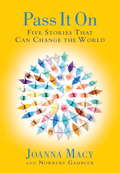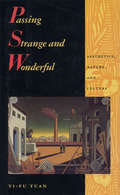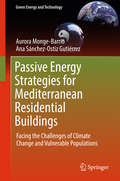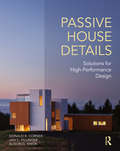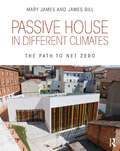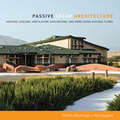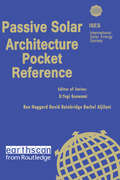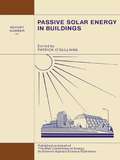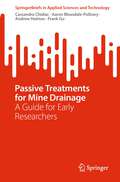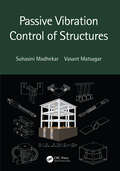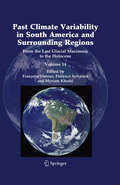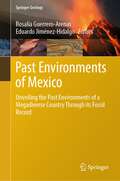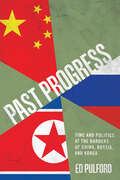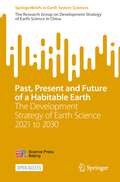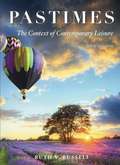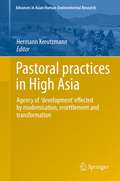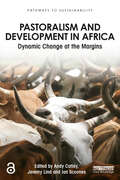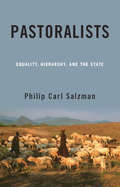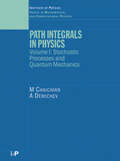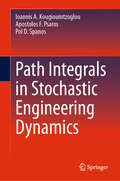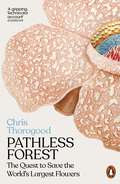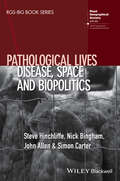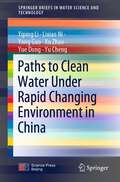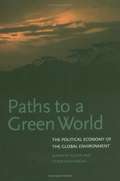- Table View
- List View
Pass it On: Five Stories That Can Change the World
by Joanna Macy Norbert GahblerEco-philosopher and best-selling author Joanna Macy, Ph.D., shares five stories from her more than thirty years of studying and practicing Buddhism and deep ecology. Gathered on her travels to India, Russia, Australia, and Tibet, these stories give testament to Joanna Macy's belief that either humankind awakens to a new and deeper understanding of our interconnectedness with our planet and all its myriad forms of life or risks loosing it. To bring about such a transformation of consciousness each and every one of us counts. Five Stories that Can Change the World tells of encounters with individuals who share very personal stories of sudden awakening, unexpected awareness, and the co-mingling of joy and pain. Each story is imbued with the specific cultural flavor of the places where the stories originate, but all share that each individual counts in the global need for change and awakening.Pas It On provides an introduction to Joanna Macy's work of "deep ecology" and "the great turning" and the deep interconnected nature of all beings.Introduction by Norbert Gahbler.
Pass the Energy, Please!
by Barbara McKinneyNature's food chains are sometimes short (grass eaten by deer) and sometimes long (goldenrod eaten by caterpillar, eaten by spider, eaten by warbler, eaten by weasel, eaten by fox). Everyone is part of nature's fascinating circle of players.
Passing Strange and Wonderful: Aesthetics Nature And Culture
by Yi-Fu TuanIn this rich and rewarding work, Yi-Fu Tuan vividly demonstrates that feeling and beauty are essential components of life and society. The aesthetic is not merely one aspect of culture but its central core -- both its driving force and its ultimate goal.Beginning with the individual and his physical world, Tuan's exploration progresses from the simple to the complex. His initial evaluation of the building blocks of aesthetic experience (sight, hearing, smell, taste, touch) develops gradually into a wide-ranging examination of the most elaborate of human constructs, including art, architecture, literature, philosophy, music, and more.
Passive Energy Strategies for Mediterranean Residential Buildings
by Aurora Monge-Barrio Ana Sánchez-Ostiz GutiérrezThis book presents an approach to energy-efficient building design, which takes into account the most important challenges in climate change mitigation and adaptation in Southern Europe. It outlines a specific approach related to residential buildings and their intergenerational and vulnerable occupants, such as ageing population and users in fuel poverty. It also focuses on the use of passive energy measures throughout the year, and on pursuing a realistic and affordable approach to the efficient rehabilitation of resilient residential buildings.In addition, the book presents case studies that include surveys, monitoring, and simulation of residential buildings in Spain and other Southern European representative locations, in order to go further on the study of this challenging topic.
Passive House Details: Solutions for High-Performance Design
by Alison G. Kwok Donald B. Corner Jan C. FillingerPassive House Details introduces the concepts, principles, and design processes of building ultralow-energy buildings. The objective of this book is to provide design goals, research, analysis, systems, details, and inspiring images of some of the most energy-efficient, carbon-neutral, healthy, and satisfying buildings currently built in the region. Other topics included: heat transfer, moisture management, performance targets, and climatic zones. Illustrated with more than 375 color images, the book is a visual catalog of construction details, materials, and systems drawn from projects contributed from forty firms. Fourteen in-depth case studies demonstrate the most energy-efficient systems for foundations, walls, floors, roofs, windows, doors, and more.
Passive House in Different Climates: The Path to Net Zero
by Mary James James BillPassive House in Different Climates introduces the seven Passive House principles, to help you create super-insulated, airtight buildings that require minimal energy use to heat, cool, dehumidify, and ventilate, with superior indoor air quality and year-round comfort. Seventeen case studies in four climate zones---marine, cold and very cold, mixed-dry and hot-dry, and mixed-humid and hot-humid---and in ten countries, show you how to achieve net-zero energy regardless of where you’re building or what type of building is required. Includes more than 150 color illustrations.
Passive Solar Architecture
by David A. Bainbridge Ken HaggardThis pocket reference book provides a wealth of practical information at your fingertips, whenever you need it. Rich in background detail, at-a-glance tables and diagrams, equations, and more, the Passive Solar Architecture Pocket Referenceis a handy resource for architects, engineers and students. Coverage includes: Definitions Load determinants and Responses (including world wide biomes and climates, building metabolism and response, thermal sources and sinks, passive building responses to sources and sinks, tuning the building to the environment, optimizing insulation & thermal mass for comfort) Contextual Aspects (including microclimate and siting, temperatures, humidity, wind, radiation and comfort parameters) Passive Components (including building envelope, passive solar terminology, orientation, apertures and glazing, thermal storage, thermal control and materials Design Tools (including sun path diagrams, sun peg diagrams, air flow relationships, thermal modelling and life cycle design) Specific Functions (including passive heating, passive cooling and ventilation, natural lighting, passive water heating, resource collection and Integrated design)
Passive Solar Architecture Pocket Reference (Energy Pocket Reference)
by David A. Bainbridge Ken Haggard Rachel AljilaniOur pocket reference books provide a wealth of practical information at your fingertips, whenever you need it. Rich in background detail, at-a-glance tables and diagrams, equations, and more, the Passive Solar Architecture Pocket Reference is a handy resource for architects, engineers and students. Coverage includes: definitions load determinants and Responses (including world wide biomes and climates, building metabolism and response, thermal sources and sinks, passive building responses to sources and sinks, tuning the building to the environment, optimizing insulation & thermal mass for comfort) contextual aspects (including microclimate and siting, temperatures, humidity, wind, radiation and comfort parameters passive components (including building envelope, passive solar terminology, orientation, apertures and glazing, thermal storage, thermal control and materials design tools (including sun path diagrams, sun peg diagrams, air flow relationships, thermal modelling and life cycle design specific functions (including passive heating, passive cooling and ventilation, natural lighting, passive water heating, resource collection and integrated design).
Passive Solar Energy in Buildings: Watt Committee: report number 17
by Patrick O´SullivanThis report indicates that the benefits that accrue to a building and its occupants from a consideration of solar radiation are greatest when the 'passive solar component' is seen in perspective, as a natural part of an integrated approach to climatically interactive low-energy building design.
Passive Treatments for Mine Drainage: A Guide for Early Researchers (SpringerBriefs in Applied Sciences and Technology)
by Andrew Holmes Cassandra Chidiac Aaron Bleasdale-Pollowy Frank GuThis book allows readers to grasp both the fundamentals and the latest technological advances in the field of mine drainage, which is increasingly crucial both environmentally and economically. Its extensive coverage of current and promising passive treatment technologies, combined with numerous practical guides, makes it an indispensable tool for early researchers seeking promising trends and identifying gaps.The book systematically explores recent literature on passive treatment research, classifying them as preventative, in-situ, and ex-situ solutions. It covers relevant passive treatments such as permeable reactive barriers, constructed wetlands, gravel bed reactors, saturated rock fills, and passivation techniques, among other common source control tactics. Each technology is discussed in terms of principal mechanisms, state-of-the-art technological advances, advantages and disadvantages, and suitability for a given mine drainage chemistry and flow regime. The book provides a comprehensive view of the entire field, offering researchers and policymakers a reference guide, research ideas, understanding, and practical applications for each technology.Furthermore, the contains an overview of recent trends in material selection for passive treatment applications, primarily through the use of industrial waste and by-products, which incorporate more sustainable practices in mine drainage remediation. Uniquely, the manuscript includes a flowchart based on water chemistry and flow rates to guide readers to ideal treatment options, along with written analysis to further support the readers’ decision-making. Overall, this equips early researchers in the field with knowledge of fundamentals and promising research routes when dealing with different mine drainage complexities while also providing them with promising research avenues that can advance the field further.
Passive Vibration Control of Structures
by Suhasini Madhekar Vasant MatsagarResearch in vibration response control deals not only with prevention of catastrophic failures of structures during natural or accidental/manmade hazards but also ensures the comfort of occupants through serviceability. Therefore, the focus of this book is on the theory of dynamic response control of structures by using different kinds of passive vibration control devices. The strategies used for controlling displacement, velocity, and acceleration response of structures such as buildings, bridges, and liquid storage tanks under the action of dynamic loads emanating from earthquake, wind, wave, and so forth are detailed. The book: Explains fundamentals of vibration response control devices and their practical applications in response mitigation of structures exposed to earthquake, wind, and wave loading Offers a comprehensive overview of each passive damper, its functioning, and mathematical modeling in a dynamical system Covers practical aspects of employing the passive control devices to some of the benchmark problems that are developed from existing buildings and bridges in different countries worldwide Includes MATLAB® codes for determining the dynamic response of single degree of freedom (SDOF) and multi-degree of freedom (MDOF) systems along with computational models of the passive control devices This book is aimed at senior undergraduate students, graduate students, and researchers in civil, earthquake, aerospace, automotive, mechanical engineering, engineering dynamics, and vibration control, including structural engineers, architects, designers, manufacturers, and other professionals.
Past Climate Variability in South America and Surrounding Regions
by Florence Sylvestre Francoise Vimeux Myriam KhodriThis book groups together overviews and original research papers dealing with South American climate variability from the Last Glacial Maximum to the Holocene. The contributions deal with tropical, temperate and high latitudes climate variability in South America and in surrounding regions (including Pacific and Atlantic Oceans and Antarctica). It offers results obtained from both natural climate archives and recent simulations from coupled climate models. The objective is to propose a state of the art about our knowledge of past climate variability in South America. Specifically, this book aims at presenting the whole available observations and at discussing climate mechanisms, specifically the low to high latitude teleconnections on that continent which spreads out from the equator to Patagonia. It is written by an expert group of climate change scientists, and presents an insight into dynamics of the past and provides climate modellers with work of reference for data-model comparison. The book is an advanced but very readable text essential for all students and scientists interested in global environmental change.
Past Environments of Mexico: Unveiling the Past Environments of a Megadiverse Country Through its Fossil Record (Springer Geology)
by Rosalía Guerrero-Arenas Eduardo Jiménez-HidalgoMexico is a biodiverse country. The dynamics of environments from Mexico played a crucial role in the history of North American biota. This book analyzes the paleoenvironmental conditions using several biological groups and various methods. This book also demonstrates how this information is specifically used to elucidate Mexico‘s past environments and habitats (terrestrial, freshwater, and marine). This book fills an existing editorial gap since much of the information is dispersed in several bibliographic sources. The authors are active paleontologists in diverse Mexican universities and research centers. Their research activities contribute to the knowledge of the Mexican biota through geologic time.
Past Progress: Time and Politics at the Borders of China, Russia, and Korea
by Ed PulfordWhile anxiety abounds in the old Cold War West that progress – whether political or economic – has been reversed, for citizens of former-socialist countries, murky temporal trajectories are nothing new. Grounded in the multiethnic frontier town of Hunchun at the triple border of China, Russia, and North Korea, Ed Pulford traces how several of global history's most ambitiously totalizing progressive endeavors have ended in cataclysmic collapse here. From the Japanese empire which banished Qing, Tsarist, and Choson dynastic histories from the region, through Chinese, Soviet, and Korean socialisms, these borderlands have seen projections and disintegrations of forward-oriented ideas accumulate on a grand scale. Taking an archaeological approach to notions of historical progress, the book's three parts follow an innovative structure moving backwards through linear time. Part I explores "post-historical" Hunchun's diverse sociopolitics since high socialism's demise. Part II covers the socialist era, discussing cross-border temporal synchrony between China, Russia, and North Korea. Finally, Part III treats the period preceding socialist revolutions, revealing how the collapse of Qing, Tsarist, and Choson dynasties marked a compound "end of history" which opened the area to projections of modernity and progress. Examining a borderland across linguistic, cultural, and historical lenses, Past Progress is a simultaneously local and transregional analysis of time, borders, and the state before, during, and since socialism.
Past, Present and Future of a Habitable Earth: The Development Strategy of Earth Science 2021 to 2030 (SpringerBriefs in Earth System Sciences)
by Res. Group Dev Strategy of Earth ScienceThis perspective of this book views Earth's various layers as a whole system, and tries to understand how to achieve harmony and sustainable development between human society and nature, with the theme of " habitability of the Earth." This book is one effort at providing an overview of some of the recent exciting advances Chinese geoscientists have made. It is the concerted team effort of a group of researchers from diverse backgrounds to generalize their vision for Earth science in the next 10 years. The book is intended for scholars, administrators of the Science and Technology policy department, and science research funding agencies. This is an open access book.
Pastimes: The Context of Contemporary Leisure (Fifth Edition)
by Ruth V. RussellOriginally published in 1996, "Pastimes" introduced an exciting new text that explored leisure and recreation philosophy and science, the various subfields, and the leisure services industry. The purpose of this fifth edition of Pastimes is to extend the discussion about leisure in society to new concepts supported by new research findings and commentary. Throughout, the author has pursued the most interesting, relevant, exciting, and contemporary information possible. First, as an introduction to the phenomenon of leisure, the book must be current. Momentous changes, actual and alleged, have always been the root of leisure expressions and experiences. To match, Pastimes again reflects a wide range of material from the disciplines of leisure studies, sociology, psychology, economics, political science, anthropology, geography, the humanities, and media and cultural studies. Second, as a learning tool, this fifth edition teaches more. It contains new illustrations of concepts through field-based cases, biographical features, exploratory activities, and research studies. While the basic organisation remains similar, in addition to new material, some former concepts have been relocated. For example, the topic of history and its meanings for leisure is now combined into one chapter. Also, the discussion of work is now combined with that about economics in the same chapter. Also, theories explaining leisure behaviour are now organised according to their home discipline. A chapter on well-being and leisure is a new feature, and because of the amazing speed of change, the chapter on leisure and technology has been completely rewritten. The chapter on time has also been expanded. Finally, the last chapter on leisure systems has a new section on professional preparation. But, more than a textbook, Pastimes is very much a point of view. Leisure is presented as a human phenomenon that is individual and collective, vital and frivolous, historical and contemporary, factual and subjective, good and bad.
Pastoral practices in High Asia
by Hermann KreutzmannIn conventional views, pastoralism was classified as a stage of civilization that needed to be abolished and transcended in order to reach a higher level of development. In this context, global approaches to modernize a rural society have been ubiquitous phenomena independent of ideological contexts. The 20th century experienced a variety of concepts to settle mobile groups and to transfer their lifestyles to modern perceptions. Permanent settlements are the vivid expression of an ideology-driven approach. Modernization theory captured all walks of life and tried to optimize breeding techniques, pasture utilization, transport and processing concepts. New insights into other aspects of pastoralism such as its role as an adaptive strategy to use marginal resources in remote locations with difficult access could only be understood as a critique of capitalist and communist concepts of modernization. In recent years a renaissance of modernization theory-led development activities can be observed. Higher inputs from external funding, fencing of pastures and settlement of pastoralists in new townships are the vivid expression of 'modern' pastoralism in urban contexts. The new modernization programme incorporates resettlement and transformation of lifestyles as to be justified by environmental pressure in order to reduce degradation in the age of climate change.
Pastoralism and Development in Africa: Dynamic Change at the Margins (Pathways to Sustainability)
by Author UnknownOnce again, the Horn of Africa has been in the headlines. And once again the news has been bad: drought, famine, conflict, hunger, suffering and death. The finger of blame has been pointed in numerous directions: to the changing climate, to environmental degradation, to overpopulation, to geopolitics and conflict, to aid agency failures, and more. But it is not all disaster and catastrophe. Many successful development efforts at ‘the margins’ often remain hidden, informal, sometimes illegal; and rarely in line with standard development prescriptions. If we shift our gaze from the capital cities to the regional centres and their hinterlands, then a very different perspective emerges. These are the places where pastoralists live. They have for centuries struggled with drought, conflict and famine. They are resourceful, entrepreneurial and innovative peoples. Yet they have been ignored and marginalised by the states that control their territory and the development agencies who are supposed to help them. This book argues that, while we should not ignore the profound difficulties of creating secure livelihoods in the Greater Horn of Africa, there is much to be learned from development successes, large and small. This book will be of great interest to students and scholars with an interest in development studies and human geography, with a particular emphasis on Africa. It will also appeal to development policy-makers and practitioners.
Pastoralists: Equality, Hierarchy, and the State
by Philip Carl SalzmanDrawing upon the author's extensive field research among pastoral peoples in the Middle East, India, and the Mediterranean, and on more than 30 years of comparative study of pastoralists around the world, Pastoralists is an authoritative synthesis of the varieties of pastoral life. At an ethnographic level, the concise volume provides detailed analyses of divergent types of pastoral societies, including segmentary tribes, tribal chiefdoms, and peasant pastoralists. At the same time, it addresses a set of substantive theoretical issues: ecological and cultural variation, equality and inequality, hierarchy and the basis of power, and state power and resistance. The book validates "pastoralists" as a conceptual category even as it reveals the diversity of societies, subsistence strategies, and power arrangements subsumed by that term.
Path Integrals in Physics: Volume I Stochastic Processes and Quantum Mechanics
by M Chaichian A DemichevPath Integrals in Physics: Volume I, Stochastic Processes and Quantum Mechanics presents the fundamentals of path integrals, both the Wiener and Feynman type, and their many applications in physics. Accessible to a broad community of theoretical physicists, the book deals with systems possessing a infinite number of degrees in freedom. It discusses the general physical background and concepts of the path integral approach used, followed by a detailed presentation of the most typical and important applications as well as problems with either their solutions or hints how to solve them. It describes in detail various applications, including systems with Grassmann variables. Each chapter is self-contained and can be considered as an independent textbook. The book provides a comprehensive, detailed, and systematic account of the subject suitable for both students and experienced researchers.
Path Integrals in Stochastic Engineering Dynamics
by Ioannis A. Kougioumtzoglou Pol D. Spanos Apostolos F. PsarosThis book organizes and explains, in a systematic and pedagogically effective manner, recent advances in path integral solution techniques with applications in stochastic engineering dynamics. It fills a gap in the literature by introducing to the engineering mechanics community, for the first time in the form of a book, the Wiener path integral as a potent uncertainty quantification tool. Since the path integral flourished within the realm of quantum mechanics and theoretical physics applications, most books on the topic have focused on the complex-valued Feynman integral with only few exceptions, which present path integrals from a stochastic processes perspective. Remarkably, there are only few papers, and no books, dedicated to path integral as a solution technique in stochastic engineering dynamics. Summarizing recently developed techniques, this volume is ideal for engineering analysts interested in further establishing path integrals as an alternative potent conceptual and computational vehicle in stochastic engineering dynamics.
Pathless Forest: The Quest to Save the World’s Largest Flowers
by Dr Chris ThorogoodThe incredible story of one man's obsession to find and protect the world's largest flowers As a child, Chris Thorogood dreamed of seeing Rafflesia - the plant with the world's largest flowers. He crafted life-size replicas in an abandoned cemetery, carefully bringing them to life with paper and paint. Today he is a botanist at the University of Oxford's Botanic Garden and has dedicated his life to studying the biology of such extraordinary plants, working alongside botanists and foresters in Southeast Asia to document these huge, mysterious blooms.Pathless Forest is the story of his journey to study and protect this remarkable plant - a biological enigma, still little understood, which invades vines as a leafless parasite and steals its food from them. We join him on a mind-bending adventure, as he faces a seemingly impenetrable barrier of weird, wonderful and sometimes fearsome flora; finds himself smacking off leeches, hanging off vines, wading through rivers; and following indigenous tribes into remote, untrodden rainforests in search of Rafflesia's ghostly, foul-smelling blooms, more than a metre across.We depend on plants for our very existence, but two in five of the world's species are threatened with extinction - nobody knows how many species of Rafflesia might already have disappeared through deforestation. Pathless Forest is part thrilling adventure story and part an inspirational call to action to safeguard a fast-disappearing wilderness. To view plants in a different way, as vital for our own future as for that of the planet we share. And to see if Rafflesia itself can be saved.
Pathological Lives: Disease, Space and Biopolitics
by John Allen Steve Hinchliffe Nick Bingham Simon CarterPandemics, epidemics and food borne diseases are a major global challenge. Focusing on the food and farming sector, and mobilising social theory as well as empirical enquiry, Pathological Lives investigates current approaches to biosecurity and ask how pathological lives can be successfully ‘regulated’ without making life more dangerous as a result. Uses empirical and social theoretical resources developed in the course of a 40-month research project entitled ‘Biosecurity borderlands’ Focuses on the food and farming sector, where the generation and subsequent transmission of disease has the ability to reach pandemic proportions Demonstrates the importance of a geographical and spatial analysis, drawing together social, material and biological approaches, as well as national and international examples The book makes three main conceptual contributions, reconceptualising disease as situated matters, the spatial or topological analysis of situations and a reformulation of biopolitics Uniquely brings together conceptual development with empirically and politically informed work on infectious and zoonotic disease, to produce a timely and important contribution to both social science and to policy debate
Paths to Clean Water Under Rapid Changing Environment in China (SpringerBriefs in Water Science and Technology)
by Yu Cheng Yue Dong Yiping Li Xu Zhao Lixiao Ni Yong GuoThis book mainly provides the current status of water pollution faced by China under rapid changing environment and the actions that have been taken for prevention and treatment of water pollution. It points out that the water pollution situation is severe. Facing water pollution, China’s experiences include several aspects on source control and pollution interception, internal nutrient removal of sediment, ecological restoration, and water transfer policy. There exists both the opportunity and challenge for the prevention and control of water pollution in China. The book contains numerous charts and diagrams which further illustrating China’s paths to clean water.
Paths to a Green World: The Political Economy of the Global Environment
by Jennifer Clapp Peter DauvergneThis comprehensive and accessible text fills the need for a political economy view of global environmental politics, focusing on the ways key economic processes affect environmental outcomes.
